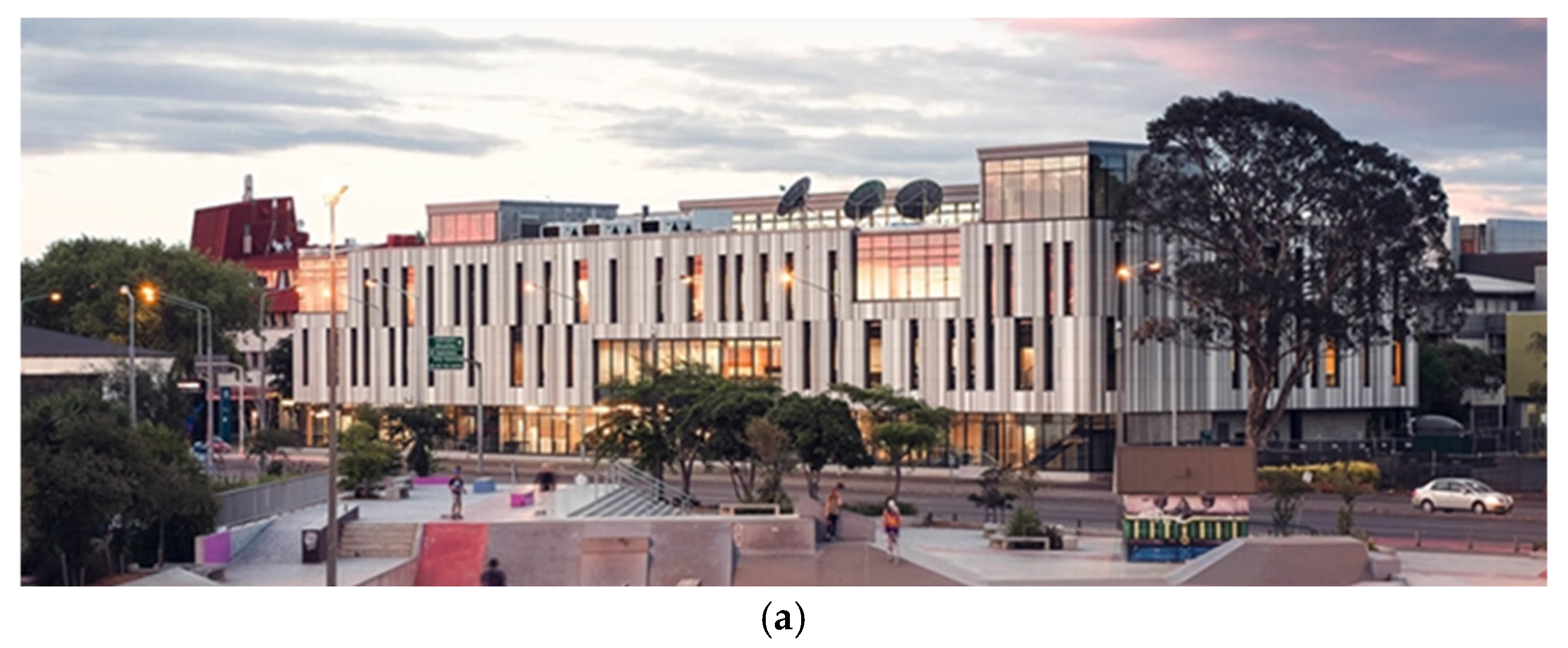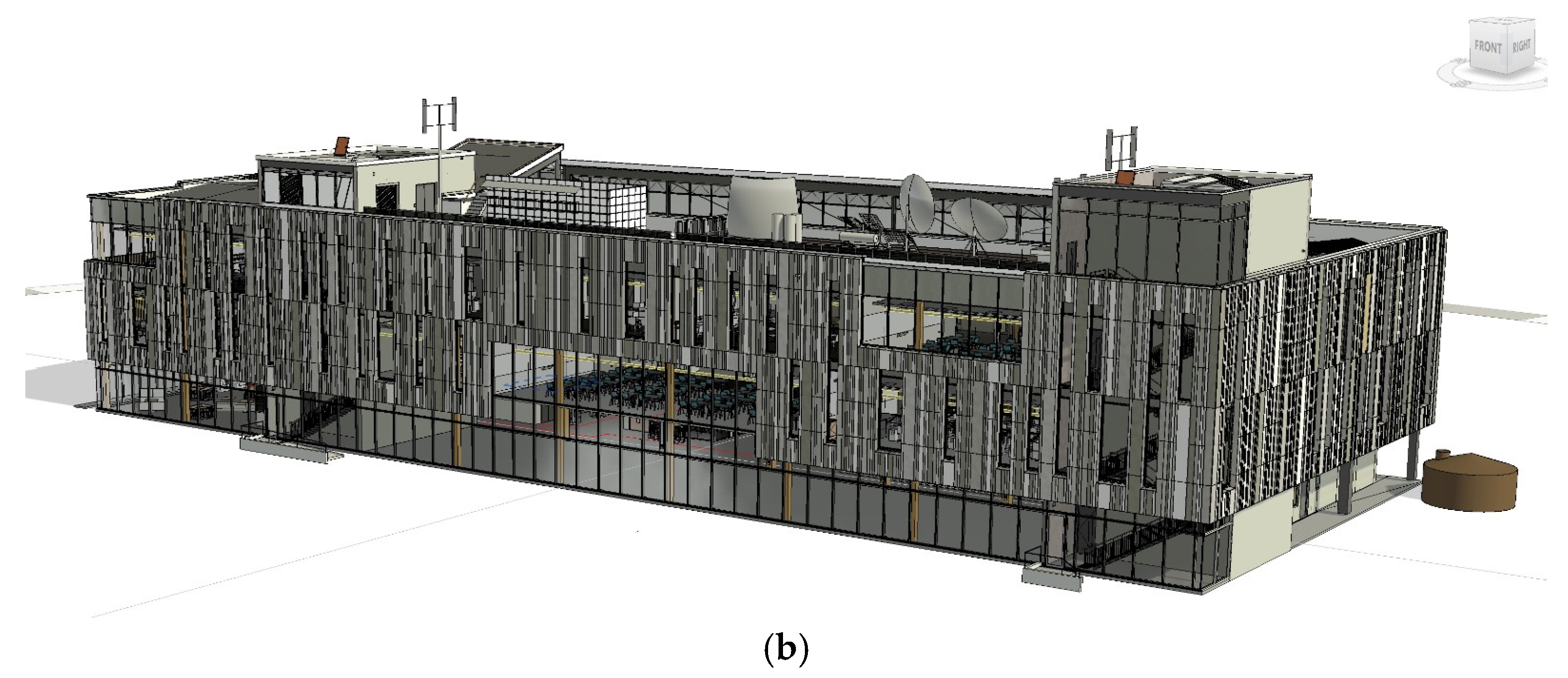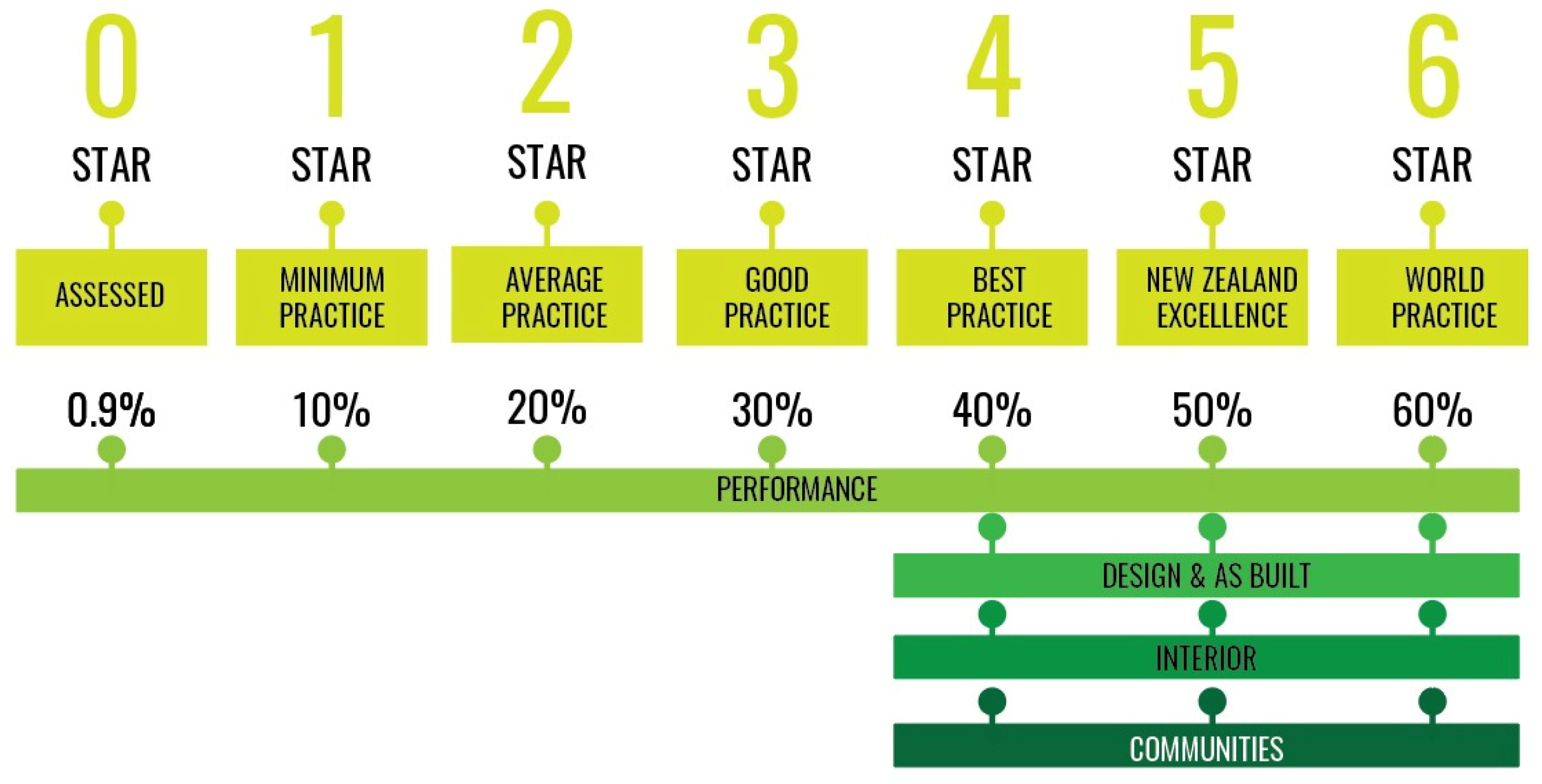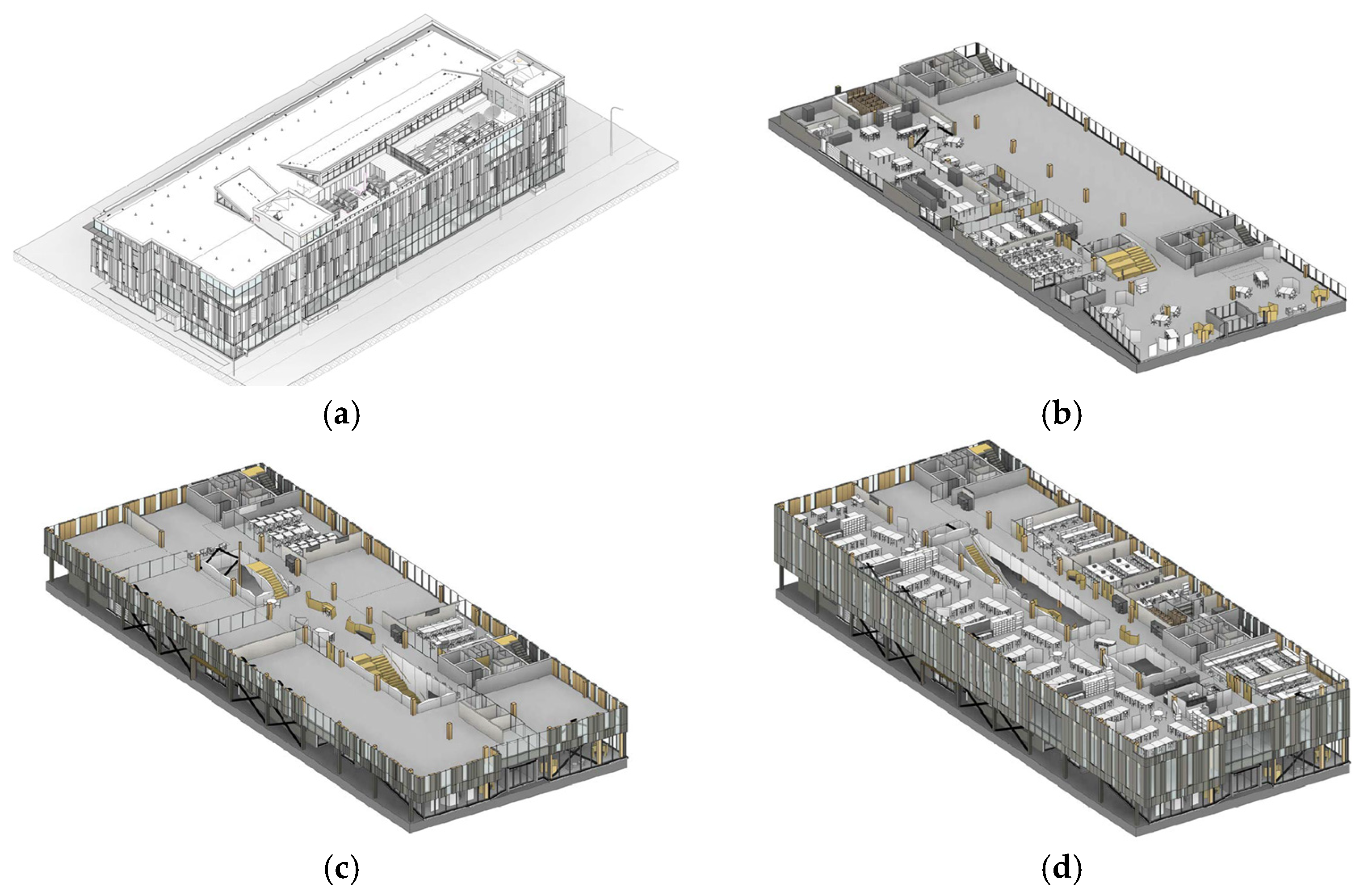Assessment of Sustainable Building Design with Green Star Rating Using BIM
Abstract
1. Introduction
2. Literature Review
3. Research Methodology
3.1. Selection of the Case Building
3.2. Green Star Rating Calculation
3.3. Building Information Modelling
3.4. BIM Utilisation for Green Star Rating
4. Results and Discussion
4.1. Green Star Rating for Case Building
4.2. BIM and Green Star Integrations
- Management: BIM models facilitated comprehensive management strategies, incorporating building information commissioning and tuning, environmental management plans, and ongoing monitoring through precise BIM data tracking and reporting.
- Indoor Environment Quality: Simulations conducted through BIM tools ensured optimal air quality, hazardous material management, thermal comfort, acoustic performance, and visual comfort, verifying compliance through detailed model simulations.
- Energy: Autodesk GBS and BIM-enabled energy modelling validated greenhouse gas emission reductions and optimized peak electricity demand, ensuring efficiency criteria were robustly met.
- Transport: BIM helped visualize and plan alternative transportation programs, enhancing accessibility and efficiency through integrated transport mode surveys and simulations.
- Water: Water conservation strategies were validated through BIM-based simulations of potable water use and fire protection services, demonstrating significant reductions against baseline consumption.
- Materials: BIM facilitated sustainable procurement processes, waste management during construction, and refurbishment phases by embedding environmental product declarations directly into the BIM model.
- Land Use and Ecology: The ecological value and biodiversity contributions were assessed using BIM tools to plan and optimize site landscaping and maintenance practices.
- Emissions: Stormwater management, light pollution control, and refrigeration impact assessments were modelled and analysed through BIM, ensuring adherence to Green Star emission reduction criteria.
- Innovation: Innovative technologies, processes, and strategies for global sustainability benchmarks were identified, modelled, and documented through advanced BIM functionalities.
4.3. Performance Evaluation
5. Conclusions
Author Contributions
Funding
Data Availability Statement
Acknowledgments
Conflicts of Interest
Abbreviations
| BEP | Building Energy Modelling |
| BIM | Building Information Modelling |
| GBS | Green Building Studio |
| IEQ | Indoor Environment Quality |
| NZGBC | New Zealand Green Building Council |
References
- Dyason, D. Disasters and investment: Assessing the performance of the underlying economy following a large-scale stimulus in the built environment. J. Risk Financ. Manag. 2022, 15, 263. [Google Scholar] [CrossRef]
- Bui, T.T.P.; Wilkinson, S.; Domingo, N. Climate change adaptation in New Zealand’s building sector. In Proceedings of the 54th International Conference of The Australian and New Zealand Architectural Science Association (ANZAScA), Auckland, New Zealand, 26–28 November 2020; pp. 236–245. [Google Scholar]
- Fullbrook, D.; Jackson, Q.; Finlay, G. Value case for sustainable building in New Zealand. In Report for the Ministry for the Environment; Ministry for the Environment: Wellington, New Zealand, 2006. [Google Scholar]
- Li, X.; Liu, Y.; Wilkinson, S.; Liu, T. Driving forces influencing the uptake of sustainable housing in New Zealand. Eng. Constr. Archit. Manag. 2019, 26, 46–65. [Google Scholar] [CrossRef]
- Cielo, D.; Subiantoro, A. Net zero energy buildings in New Zealand: Challenges and potentials reviewed against legislative, climatic, technological, and economic factors. J. Build. Eng. 2021, 44, 102970. [Google Scholar] [CrossRef]
- Finnie, D.A.; Masood, R.; Goldsworthy, S.; Harding, B. Embodied Carbon in New Zealand Commercial Construction. Energies 2024, 17, 2629. [Google Scholar] [CrossRef]
- Nidhin, B.K.S.N.; Domingo, N.; Bui, T.T.P.; Wilkinson, S. Construction stakeholders’ knowledge on zero carbon initiatives in New Zealand. Int. J. Build. Pathol. Adapt. 2025, 43, 512–527. [Google Scholar] [CrossRef]
- Smith, J. Implementation of a Building Sustainability Rating Tool: A Survey of the New Zealand Building Industry. Masters’s thesis, Open Access Te Herenga Waka-Victoria University of Wellington, Wellington, New Zealand, 2008. [Google Scholar]
- Doan, D.T.; Wall, H.; Ghaffarian Hoseini, A.; Ghaffarianhoseini, A.; Naismith, N. Green building practice in the New Zealand construction industry: Drivers and limitations. Int. J. Technol. 2021, 12, 946–955. [Google Scholar] [CrossRef]
- Doan, D.T.; Ghaffarianhoseini, A.; Naismith, N.; Zhang, T.; Ghaffarianhoseini, A.; Tookey, J. A critical comparison of green building rating systems. Build. Environ. 2017, 123, 243–260. [Google Scholar] [CrossRef]
- Liang, J.; Vishnupriya, V.; Le, A.; Shen, X. Future directions for advancing Green Star NZ to achieve zero-carbon goals: Insights from industry professionals. Int. J. Build. Pathol. Adapt. 2025, 43, 41–58. [Google Scholar] [CrossRef]
- Smith, R.; Reid, V.; Smith, D.; Rodwell, J.; Rayburg, S.; Neave, M. Reorienting Green Ratings Towards the Big Problems Rather than Business as Usual: A Review of Pragmatic Issues. Buildings 2025, 15, 1915. [Google Scholar] [CrossRef]
- Byrd, H.; Rasheed, E.O. The Productivity Paradox in Green Buildings. Sustainability 2016, 8, 347. [Google Scholar] [CrossRef]
- GhaffarianHoseini, A.; Tien Doan, D.; Naismith, N.; Tookey, J.; GhaffarianHoseini, A. Amplifying the practicality of contemporary building information modelling (BIM) implementations for New Zealand green building certification (Green Star). Eng. Constr. Archit. Manag. 2017, 24, 696–714. [Google Scholar] [CrossRef]
- Wong, J.K.W.; Zhou, J. Enhancing environmental sustainability over building life cycles through green BIM: A review. Autom. Constr. 2015, 57, 156–165. [Google Scholar] [CrossRef]
- Carvalho, J.P.; Bragança, L.; Mateus, R. A systematic review of the role of BIM in building sustainability assessment methods. Appl. Sci. 2020, 10, 4444. [Google Scholar] [CrossRef]
- Doan, D.T.; GhaffarianHoseini, A.; Naismith, N.; Ghaffarianhoseini, A.; Zhang, T.; Tookey, J. Examining critical perspectives on building information modelling (BIM) adoption in New Zealand. Smart Sustain. Built Environ. 2021, 10, 594–615. [Google Scholar] [CrossRef]
- Doan, D.T.; Ghaffarianhoseini, A.; Naismith, N.; Ghaffarianhoseini, A.; Tookey, J. Developing a framework for building information modelling (BIM) adoption in New Zealand. Built Environ. Proj. Asset Manag. 2024, 14, 490–506. [Google Scholar] [CrossRef]
- Płoszaj-Mazurek, M.; Ryńska, E. Artificial intelligence and digital tools for assisting low-carbon architectural design: Merging the use of machine learning, large language models, and building information modeling for life cycle assessment tool development. Energies 2024, 17, 2997. [Google Scholar] [CrossRef]
- Cao, Y.; Kamaruzzaman, S.N.; Aziz, N.M. Green building construction: A systematic review of BIM utilization. Buildings 2022, 12, 1205. [Google Scholar] [CrossRef]
- Lu, Y.; Wu, Z.; Chang, R.; Li, Y. Building Information Modeling (BIM) for green buildings: A critical review and future directions. Autom. Constr. 2017, 83, 134–148. [Google Scholar] [CrossRef]
- Uddin, M.N.; Wei, H.H.; Chi, H.L.; Ni, M.; Elumalai, P. Building information modeling (BIM) incorporated green building analysis: An application of local construction materials and sustainable practice in the built environment. J. Build. Pathol. Rehabil. 2021, 6, 13. [Google Scholar] [CrossRef]
- Hajj, E.C.I.; Montes, G.M. Examining green building practices: The influence on building information modeling function diffusion. Sustainability 2025, 17, 3843. [Google Scholar] [CrossRef]
- Krygiel, E.; Nies, B. Green BIM: Successful Sustainable Design with Building Information Modeling; John Wiley & Sons: Hoboken, NJ, USA, 2008. [Google Scholar]
- Gonzalez, R.E.; Stephens, M.T.; Toma, C.; Dowdell, D. Incorporating potential environmental impacts in building seismic design decisions. Bull. Earthq. Eng. 2023, 21, 4385–4428. [Google Scholar] [CrossRef]
- Peng, W.; Feng, Z. The applications of building information modelling for the lifecycle performance of green buildings: A systematic literature review. In Proceedings of the 7th New Zealand Built Environment Research Symposium (NZBERS), Auckland, New Zealand, 17–18 February 2022. [Google Scholar]
- Olanrewaju, O.I.; Enegbuma, W.I.; Donn, M.; Chileshe, N. Building information modelling and green building certification systems: A systematic literature review and gap spotting. Sustain. Cities Soc. 2022, 81, 103865. [Google Scholar] [CrossRef]
- Kamaruzzaman, S.N.; Salleh, H.; Lou, E.; Edwards, R.; Wong, P.F. Assessment schemes for sustainability design through BIM: Lessons learnt. In Proceedings of the 4th International Building Control Conference, Kuala Lumpur, Malaysia, 7–8 March 2016; p. 80. [Google Scholar]
- Abdelaal, F.; Guo, B.H. Stakeholders’ perspectives on BIM and LCA for green buildings. J. Build. Eng. 2022, 48, 103931. [Google Scholar] [CrossRef]
- Mobaraki, A.; Nikoofam, M.; Mobaraki, B. The Nexus of Morphology and Sustainable Urban Form Parameters as a Common Basis for Evaluating Sustainability in Urban Forms. Sustainability 2025, 17, 3967. [Google Scholar] [CrossRef]
- Doan, D.T.; Ghaffarianhoseini, A.; Naismith, N.; Ghaffarianhoseini, A.; Zhang, T.; Tookey, J. Examining Green Star certification uptake and its relationship with Building Information Modelling (BIM) adoption in New Zealand. J. Environ. Manag. 2019, 250, 109508. [Google Scholar] [CrossRef]
- Gandhi, S.; Jupp, J. BIM and Australian green star building certification. In Proceedings of the Computing in Civil and Building Engineering (2014), Orlando, FL, USA, 23–25 June 2014; pp. 275–282. [Google Scholar]
- Ly, L.; Kiroff, L. BIM use in green building certification processes. In Proceedings of the International Structural Engineering and Construction, Chicago, IL, USA, 11–18 August 2023; pp. 1–6. [Google Scholar]
- Liu, Z.; Wang, Q.; Gan, V.J.; Peh, L. Envelope thermal performance analysis based on building information model (BIM) cloud platform—Proposed green mark collaboration environment. Energies 2020, 13, 586. [Google Scholar] [CrossRef]
- Renganathan, R. Investigating the Role of BIM and Simulation Tools in Promoting Energy Efficiency for Green Building Certification. Renew. Energy 2025, 1, 50–70. [Google Scholar] [CrossRef]
- Gelder, J.; Agrawal, M.; Miller, J. Green Star Communities Rating Tool: An Assessment; CRC Low Carbon Living: Sydney, Australia, 2018. [Google Scholar]
- Ferdosi, H.; Abbasianjahromi, H.; Banihashemi, S.; Ravanshadnia, M. BIM applications in sustainable construction: Scientometric and state-of-the-art review. Int. J. Constr. Manag. 2023, 23, 1969–1981. [Google Scholar] [CrossRef]
- Alves Tenório de Morais, G.; RS de MS Nascimento, C.; dos Santos, E.B.; MN de Souza, K.; Fernandes, B.S.; Palha, R.P. Integration potential between REVIT and LEED: A review. Archit. Eng. Des. Manag. 2024, 20, 510–525. [Google Scholar] [CrossRef]
- Alfalah, G.; Al-Sakkaf, A.; Abdelkader, E.M. On the exploration of building information modeling capabilities for promoting sustainability-related practices in construction projects: Case studies in china and usa. WSEAS Trans. Environ. Dev. 2021, 17, 764–786. [Google Scholar] [CrossRef]
- Al Aamri, A.M.S.; Evdorides, H.; Baniotopoulos, C. Barriers and Opportunities for the Adoption of Building Information Modelling in the Design of Buildings: Case Study of Oman. Sustainability 2025, 17, 3510. [Google Scholar] [CrossRef]
- Fauzi, M.A.; Anuar, K.F.; Mohd Zainudin, N.; Ahmad, M.H.; Wider, W. Building information modeling (BIM) in green buildings: A state-of-the-art bibliometric review. Int. J. Build. Pathol. Adapt. 2023. [Google Scholar] [CrossRef]
- Arbabi, A.; Taherkhani, R.; Ansari, R. A novel approach for integrating BIM and green building rating systems in the construction projects design phase. Eng. Constr. Archit. Manag. 2024. [Google Scholar] [CrossRef]
- Nwaogbe, G.; Urhoghide, O.; Ekpenyong, E.; Emmanuel, A. Green construction practices: Aligning environmental sustainability with project efficiency. Int. J. Sci. Res. Arch. 2025, 14, 189–201. [Google Scholar] [CrossRef]
- Abdelaal, F. Integrating Building Information Modelling (BIM) and Whole Building Life Cycle Assessment (WBLCA) for Green Building Rating Systems. Ph.D. Thesis, University of Canterbury, Christchurch, New Zealand, 2021. [Google Scholar]
- Alves, J.L.; Palha, R.P.; de Almeida Filho, A.T. BIM-Based Framework for Photovoltaic Systems: Advancing Technologies, Overcoming Challenges, and Enhancing Sustainable Building Performance. Sustainability 2025, 17, 3695. [Google Scholar] [CrossRef]
- Tabrizi, A. Sustainable construction, LEED as a green rating system and the importance of moving to NZEB. E3S Web Conf. 2021, 241, 02001. [Google Scholar] [CrossRef]
- BIMinNZ. ARA Institute of Canterbury Kahukura Block. Available online: https://www.biminnz.co.nz/casestudies/2017/ara-institute-of-canterbury-kahukura-block (accessed on 3 February 2025).
- Jasmax. Kahukura—A Mass Timber and Net Zero-Ready Learning Building for Ara. Available online: https://jasmax.com/projects/ara-institute-kahukura (accessed on 3 February 2025).
- NZGBC. Green Star Certification. Available online: https://nzgbc.org.nz/introduction-to-green-star (accessed on 3 February 2025).
- Doocy, L.E.; Zarmehr, A.; Kider, J.T., Jr. A critical review of the effectiveness of the Sustainability Tracking, Assessment & Rating System (STARS) framework on campus sustainability. Build. Simul. 2021, 17, 629–635. [Google Scholar]
- Maskil-Leitan, R.; Gurevich, U.; Reychav, I. BIM management measure for an effective green building project. Buildings 2020, 10, 147. [Google Scholar] [CrossRef]
- Narcida, L.; O’Dell, M.; Pacheco, M.; Perla, C.; Ramirez, V.; Sanchez, D.; Shoemaker, J.; Songco, L.; Zirakian, T.; Boyajian, D. Undergraduate Design and Analysis of a LEED Certified Building. J. Civ. Eng. Archit. 2022, 16, 227–234. [Google Scholar]
- Borkowski, A.S. A Literature Review of BIM Definitions: Narrow and Broad Views. Technologies 2023, 11, 176. [Google Scholar] [CrossRef]
- Masood, R.; Kharal, M.; Nasir, A. Is BIM adoption advantageous for construction industry of Pakistan? Procedia Eng. 2014, 77, 229–238. [Google Scholar] [CrossRef]
- Jankovic, L.; Carta, S. Biozero—Designing nature-inspired net-zero building. Sustainability 2021, 13, 7658. [Google Scholar] [CrossRef]
- Escobar, K.A.; Valles, A.I.A.A.; Campoverde, T.O.C.; Herrera, R.F. Assessment of BIM use in the early stages of implementation. Rev. Ing. Construcción 2021, 36, 311–321. [Google Scholar]
- Solla, M.; Elmesh, A.; Memon, Z.A.; Ismail, L.H.; Kazee, M.F.A.; Latif, Q.B.a.I.; Yusoff, N.I.M.; Alosta, M.; Milad, A. Analysis of BIM-based digitising of Green Building Index (GBI): Assessment method. Buildings 2022, 12, 429. [Google Scholar] [CrossRef]
- Zhang, D.; Zhang, J.; Guo, J.; Xiong, H. A semantic and social approach for real-time green building rating in BIM-based design. Sustainability 2019, 11, 3973. [Google Scholar] [CrossRef]
- Lim, Y.-W.; Chong, H.-Y.; Ling, P.C.; Tan, C.S. Greening existing buildings through Building Information Modelling: A review of the recent development. Build. Environ. 2021, 200, 107924. [Google Scholar] [CrossRef]
- Autodesk. Autodesk Insight. Available online: https://www.autodesk.com/products/insight/overview (accessed on 1 June 2024).
- Zhao, X.-g.; Gao, C.-P. Research on Energy-Saving Design Method of Green Building Based on BIM Technology. Sci. Program. 2022, 2022, 2108781. [Google Scholar] [CrossRef]
- Arisanti, K.; Latief, Y.; Machfudiyanto, R. Development information system for building maintenance for structural components of government green building using Building Information Modelling (BIM). IOP Conf. Ser. Mater. Sci. Eng. 2020, 830, 022060. [Google Scholar] [CrossRef]
- Pham, D.H.; Kim, B.; Lee, J.; Ahn, Y. An investigation of the selection of LEED version 4 credits for sustainable building projects. Appl. Sci. 2020, 10, 7081. [Google Scholar] [CrossRef]
- Li, L.; Gao, L.; Zhang, X.; Xu, H.; Jiang, L. Research on Building’s Carbon Emission Calculation and Reduction Strategy Based on Life Cycle Assessment (LCA) and Building in Formation Modeling (BIM): A Case Study in Beijing, China. Buildings 2025, 15, 1403. [Google Scholar] [CrossRef]
- Long, R.; Li, Y. Analysis of Designing Green Architecture Based on Building Information Modeling (BIM) Technology. IOP Conf. Ser. Earth Environ. Sci. 2021, 827, 012018. [Google Scholar] [CrossRef]
- Sonkamble, R.G.; Bongale, A.M.; Phansalkar, S.; Sharma, A.; Rajput, S. Secure data transmission of electronic health records using blockchain technology. Electronics 2023, 12, 1015. [Google Scholar] [CrossRef]
- Deng, R.; Li, X.; Tian, Y. A Review: The Application of Path Optimization Algorithms in Building Mechanical, Electrical, and Plumbing Pipe Design. Buildings 2025, 15, 2093. [Google Scholar] [CrossRef]
- De Castro, A.V.; Pacheco, G.R.; González, F.J.N. Holistic approach to the sustainable commercial property business: Analysis of the main existing sustainability certifications. Int. J. Strateg. Prop. Manag. 2020, 24, 251–268. [Google Scholar] [CrossRef]




| Green Star Process | BIM Methodology | LoD |
|---|---|---|
| Meet the requirements | BIM approach and plan | 100–200 |
| Design and submission | BIM development and coordination | 200–400 |
| Assessment | BIM documentation review and management | 200–500 |
| Certification | Add value through the BIM lifecycle | 100–500 |
| Category | Maximum Points Available | K Block Target Points |
|---|---|---|
| Management | 15 | 10 |
| Indoor Air Quality | 17 | 10 |
| Energy | 22 | 12 |
| Transport | 10 | 7 |
| Water | 12 | 5 |
| Total | 76 | 44 |
| Green Star Rating Subcategory | BIM Functionalities | ||||||||
|---|---|---|---|---|---|---|---|---|---|
| BEP | GBS | Insight | 2D | 3D | 4D | 5D | 6D | 7D | |
| 1. Management | |||||||||
| Green Star Accredited Professional | ✓ | ✓ | ✓ | ✓ | ✓ | ✓ | ✓ | ✓ | ✓ |
| Building Information | ✓ | ✓ | ✓ | ✓ | ✓ | ✓ | ✓ | ✓ | ✓ |
| Commissioning & Tuning | ✓ | ✓ | ✓ | ✓ | ✓ | ||||
| Ongoing Monitoring & Metering | ✓ | ✓ | ✓ | ✓ | ✓ | ✓ | |||
| Environmental Management | ✓ | ✓ | ✓ | ✓ | ✓ | ✓ | ✓ | ||
| Green Cleaning | ✓ | ✓ | ✓ | ✓ | ✓ | ✓ | ✓ | ||
| Commitment to Performance | ✓ | ✓ | ✓ | ✓ | ✓ | ✓ | ✓ | ||
| 2. Indoor Environment Quality | |||||||||
| Quality of Indoor Air | ✓ | ✓ | ✓ | ✓ | ✓ | ✓ | |||
| Hazardous Materials | ✓ | ✓ | ✓ | ✓ | ✓ | ✓ | |||
| Lighting Comfort | ✓ | ✓ | ✓ | ✓ | ✓ | ✓ | |||
| Daylight & Views | ✓ | ✓ | ✓ | ✓ | ✓ | ✓ | |||
| Thermal Comfort | ✓ | ✓ | ✓ | ✓ | ✓ | ✓ | |||
| Acoustic Comfort | ✓ | ✓ | ✓ | ✓ | ✓ | ✓ | |||
| Occupancy Comfort Survey | ✓ | ✓ | ✓ | ✓ | ✓ | ✓ | |||
| 3. Energy | |||||||||
| Greenhouse Gas Emissions | ✓ | ✓ | ✓ | ✓ | ✓ | ✓ | ✓ | ✓ | |
| Peak Electricity Demand | ✓ | ✓ | ✓ | ✓ | ✓ | ||||
| 4. Transport | |||||||||
| Alternative Transportation Program | ✓ | ||||||||
| Transportation Modes Survey | ✓ | ||||||||
| 5. Water | |||||||||
| Potable Water | ✓ | ✓ | ✓ | ||||||
| Fire Protection Services | ✓ | ✓ | |||||||
| 6. Materials | |||||||||
| Procurement & purchasing | ✓ | ✓ | ✓ | ✓ | ✓ | ✓ | ✓ | ||
| Waste from Operations | ✓ | ✓ | ✓ | ✓ | ✓ | ✓ | ✓ | ||
| Waste from Refurbishments | ✓ | ✓ | ✓ | ✓ | ✓ | ✓ | ✓ | ✓ | |
| 7. Land Use | |||||||||
| Biodiversity and Ecological Value | ✓ | ||||||||
| Groundskeeping Practices | ✓ | ||||||||
| 8. Emissions | |||||||||
| Stormwater Control | ✓ | ✓ | ✓ | ||||||
| Light Pollution | ✓ | ✓ | ✓ | ||||||
| Impacts from Refrigeration | ✓ | ✓ | ✓ | ||||||
| 9. Innovation | |||||||||
| Innovative Technology or Process | ✓ | ✓ | ✓ | ✓ | ✓ | ✓ | ✓ | ||
| Market Transformation | ✓ | ✓ | ✓ | ✓ | ✓ | ||||
| Improving Green Star Benchmarks | ✓ | ✓ | ✓ | ✓ | ✓ | ✓ | |||
| Global Sustainability | ✓ | ✓ | ✓ | ✓ | ✓ | ||||
| Innovation Challenge | ✓ | ✓ | ✓ | ✓ | ✓ | ✓ | |||
Disclaimer/Publisher’s Note: The statements, opinions and data contained in all publications are solely those of the individual author(s) and contributor(s) and not of MDPI and/or the editor(s). MDPI and/or the editor(s) disclaim responsibility for any injury to people or property resulting from any ideas, methods, instructions or products referred to in the content. |
© 2025 by the authors. Licensee MDPI, Basel, Switzerland. This article is an open access article distributed under the terms and conditions of the Creative Commons Attribution (CC BY) license (https://creativecommons.org/licenses/by/4.0/).
Share and Cite
Ahmed, M.S.; Masood, R. Assessment of Sustainable Building Design with Green Star Rating Using BIM. Energies 2025, 18, 3994. https://doi.org/10.3390/en18153994
Ahmed MS, Masood R. Assessment of Sustainable Building Design with Green Star Rating Using BIM. Energies. 2025; 18(15):3994. https://doi.org/10.3390/en18153994
Chicago/Turabian StyleAhmed, Mazharuddin Syed, and Rehan Masood. 2025. "Assessment of Sustainable Building Design with Green Star Rating Using BIM" Energies 18, no. 15: 3994. https://doi.org/10.3390/en18153994
APA StyleAhmed, M. S., & Masood, R. (2025). Assessment of Sustainable Building Design with Green Star Rating Using BIM. Energies, 18(15), 3994. https://doi.org/10.3390/en18153994






